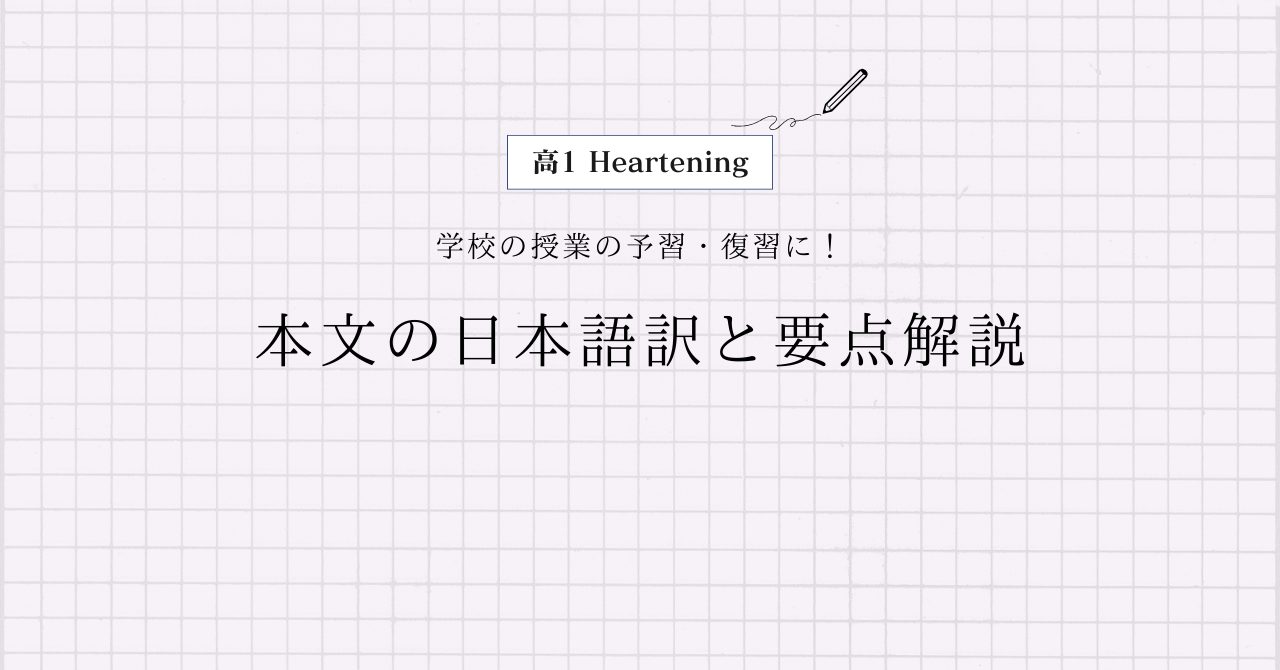桐原書店 高1Heartening Lesson7 Section1の本文の日本語訳と重要箇所の解説です。
Lesson7-2, 7-3, 7-4の解説はこちらからご覧ください。
>高1Heartening Lesson7 Section2 本文和訳
>高1Heartening Lesson7 Section3 本文和訳
>高1Heartening Lesson7 Section4 本文和訳
- Heartening Lesson7 Section1 本文と日本語訳
- Heartening Lesson7 Section1 重要事項の解説
- You are attending a lecture about the fashion industry.
- Let’s say you want to buy a polo shirt that costs 14 Canadian dollars.
- How much of that money goes to the garment worker?
- In 2011, a company in Canada looked into this.
- These polo shirts are manufactured in Bangladesh, and the production cost for one polo shirt is .67.
- Of that amount, only two percent is paid to the worker; that is one-fifth of the factory owners portion.
- For that shirt, the worker can expect to earn less than one percent of the market price.
- The polo shirt is made in Bangladesh for a good reason.
- Therefore, most companies are apt to use workers overseas who work for low wages so that they can produce shirts at a low cost.
- The apparel maker thinks that the low-priced products will sell well.
- Heartening Lesson7 Section1 まとめ
Heartening Lesson7 Section1 本文と日本語訳
You are attending a lecture about the fashion industry.
「あなたはファッション業界についての講義に出席しています。」
Let’s say you want to buy a polo shirt that costs 14 Canadian dollars.
「例えば、あなたが14カナダ・ドルのポロシャツを買いたいとしましょう。」
How much of that money goes to the garment worker?
「そのお金のいくらが衣料業界の労働者に渡るのでしょうか?」
In 2011, a company in Canada looked into this.
「2011年、カナダの会社がこれを調査しました。」
These polo shirts are manufactured in Bangladesh, and the production cost for one polo shirt is $5.67.
「これらのポロシャツはバングラデシュで作られ、ポロシャツ1つの生産コストは5.67ドルです。」
Of that amount, only two percent is paid to the worker; that is one-fifth of the factory owners portion.
「その金額のうち2%、つまり工場主の取り分の5分の1しか労働者には支払われません。」
For that $14 shirt, the worker can expect to earn less than one percent of the market price.
「その14ドルのシャツだと、労働者は市場価格の1%より少ない金額しか手にすることが期待できません。」
The polo shirt is made in Bangladesh for a good reason.
「そのポロシャツは正当な理由でバングラデシュで作られています。」
The apparel maker thinks that the low-priced products will sell well.
「アパレルメーカーは、低価格の製品はよく売れるだろうと考えています。」
Therefore, most companies are apt to use workers overseas who work for low wages so that they can produce shirts at a low cost.
「そのため、ほとんどの会社は低価格でシャツを生産するために、低賃金で働く海外の労働者を使う傾向にあります。」
One month’s salary at the local factory is about 5,000 yen.
「現地の工場での月給は約5,000円です。」
It is lower than the money a high school student can earn from a part-time job in a day in Japan.
「それは、高校生が日本で1日にアルバイトで稼ぐことができる金額よりも低いです。」

Heartening Lesson7 Section1 重要事項の解説
You are attending a lecture about the fashion industry.
ここでは「現在進行形」が使われていますね。
“attend”は「に出席する」という動詞、“lecture“は「講義、講演」、“indusry”は「業界、工業、産業」という名詞になります。
Let’s say you want to buy a polo shirt that costs 14 Canadian dollars.
“Let’s say~”は「例えば~とする、仮に~だとする」といった表現です。
“want to 動詞の原形”で「~したい」という重要表現です!「不定詞の名詞的用法」と一緒に確認しておきましょう。
“polo shirt”は「ポロシャツ」、“Canadian dollar”は「カナダ・ドル」という名詞で、“cost”は「(お金が)かかる」という動詞です。
また、“that”は「主格の関係代名詞」で“that costs 14 Canadian dollars”が先行詞“a polo shirt”を修飾しています。
How much of that money goes to the garment worker?
“how much~”は「どれくらいの~」という程度を表す疑問詞です。
“of”は前置詞で,”A of B”の形で「BのA」というように後ろから前に訳します。
“that”は「その」という形容詞で、“garment”は「衣類、衣服」、“worker”は「労働者」という名詞になります。
In 2011, a company in Canada looked into this.
“company”は「会社」という名詞で、“look into~”は「~を調査する、~の中を見る」という意味です。
“this”は直前の文全体を指していますね。
These polo shirts are manufactured in Bangladesh, and the production cost for one polo shirt is .67.
“these”は“this”の複数形で,「これらは(の)」といった意味になります。
“manufacture”は「を作る、製造する」という動詞で、ここでは「受動態」になっていますね。
“Bangladesh”は「バングラデシュ」、“production”は「生産、製品」、“cost”は「コスト、費用」という名詞です。
“cost for~”は「~の費用」という意味になります。
Of that amount, only two percent is paid to the worker; that is one-fifth of the factory owners portion.
この“of”は「~のうち」という意味の前置詞です。
“amount”は「金額、量」という名詞で、“that amount”は“$5.67”を指していますね。
“only”は「たった~しか、~だけ」という副詞です。
“pay”は「を支払う」という動詞で、ここでは「受動態」になっていますね。
「;」は「セミコロン」といって,2つの文章を繋ぐ「接続詞」のような働きをします。
“that”は“only two percent”を指していて、“factory”は「工場」、“owner”は「所有者、持ち主」、“portion”は「取り分、分け前、部分」といった名詞です。
“one-fifth”は「5分の1」という意味で、“数字-序数”という形で分数を表します。分詞(数字)が2以上のときは、序数(分母)に複数形の”s”を付けますよ。
For that shirt, the worker can expect to earn less than one percent of the market price.
この“for”は「~では」くらいで訳せばOKです。“that”は「あの、その」という形容詞で、初めにたとえで出てきた14ドルのことですね。
“expect”は「を期待する、予期する」という動詞で、“expect to 動詞の原形”で「~するのを期待する」となります。“to 動詞の原形”を「動名詞」に変えることはできません。
“earn”は「を稼ぐ」という動詞で、“earn less than~”は「~より収入が少ない」という表現です。
“market price”は「市場価格」という名詞になります。
The polo shirt is made in Bangladesh for a good reason.
ここでは「受動態」が使われていますね。
“reason”は「理由」という名詞で、“for a good reason”は「正当な理由で」という意味です。
Therefore, most companies are apt to use workers overseas who work for low wages so that they can produce shirts at a low cost.
“therefore”は「そのため、その結果」という副詞です。
“most”は「ほとんどの」という形容詞で、“be apt to 動詞の原形”は「~する傾向にある、~しがちである」という重要表現、“overseas”は「海外の、外国の」という形容詞ですね。
“who”は「主格の関係代名詞」で、“who work for low wages”が先行詞“workers overseas”を修飾しています。
“low”は「低い」という形容詞、“wage”は「賃金」という名詞です。
“so that~”は「~のため」という重要表現で、“they”は“most companies”を指していますね。
“produce”は「を生産する」という動詞で、“at a low cost”は「低価格で」という意味になります。
The apparel maker thinks that the low-priced products will sell well.
“apparel”は「アパレル、衣類」、“maker”は「メーカー、製作者」といった名詞です。
“thinks”の後ろには「接続詞that」がありますね。
“low-priced”は「低価格の」といった形容詞、“product”は「製品、商品」という名詞になります。
“sell”は「売れる」という動詞で、“well”は「よく、上手に」という副詞です。
Heartening Lesson7 Section1 まとめ
以上がHeartening Lesson7 Section1の日本語訳となります。
>高1Heartening Lesson7 Section2 本文和訳
>高1Heartening Lesson7 Section3 本文和訳
>高1Heartening Lesson7 Section4 本文和訳
何か分からない点や他に解説してほしい点があれば,お気軽にコメントしてください!


コメント